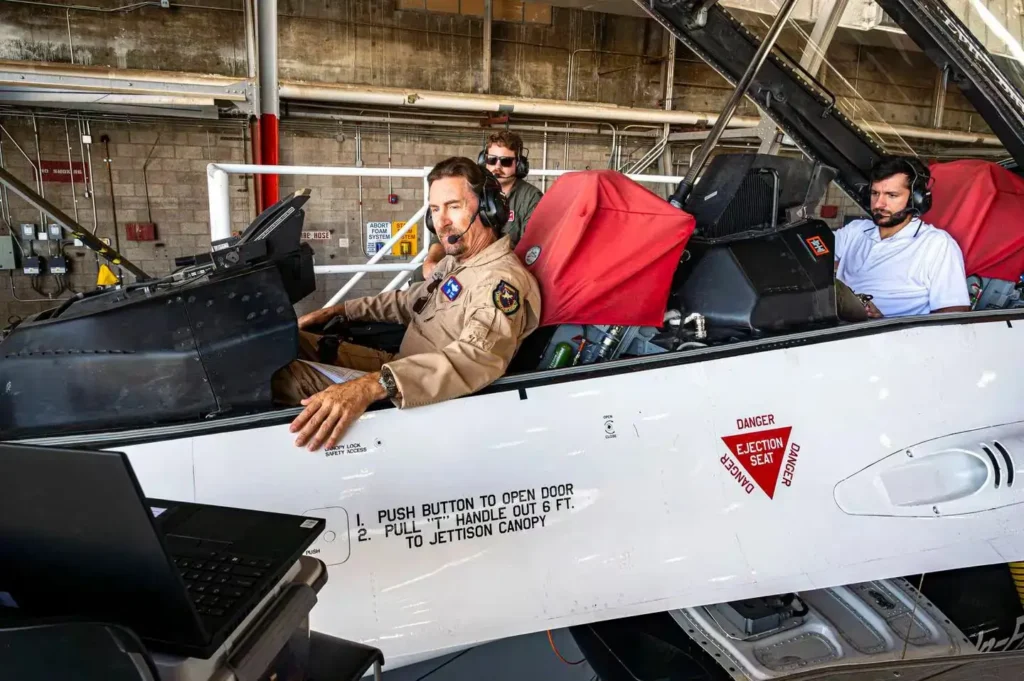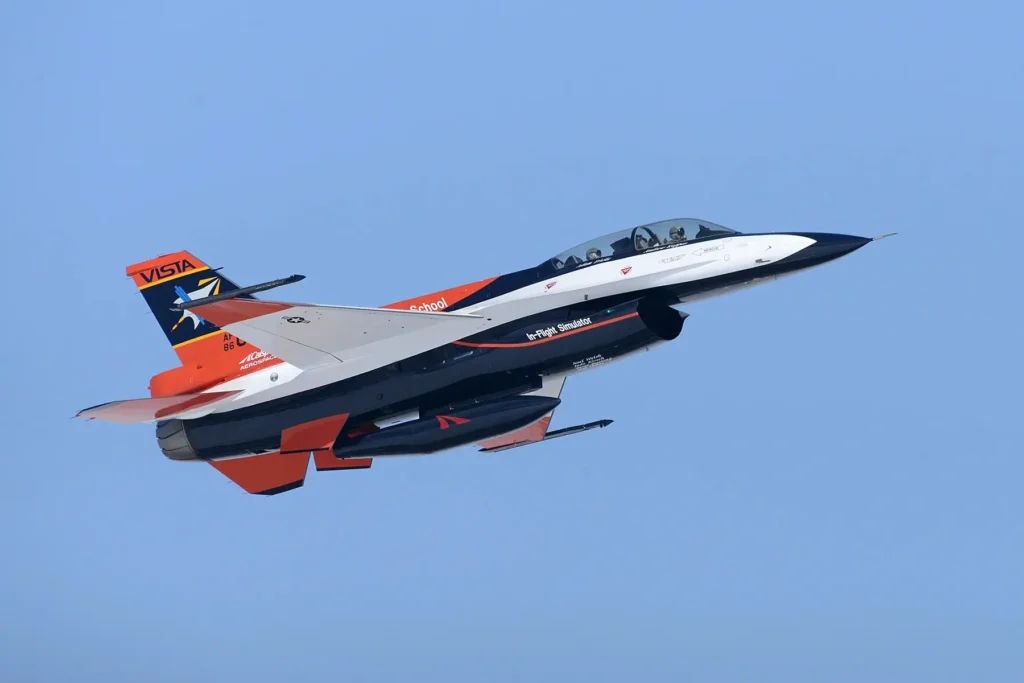The US Air Force, in collaboration with the Defense Advanced Research Projects Agency (DARPA), has achieved a significant milestone in developing autonomous aerial combat capabilities. An experimental fighter jet, the X-62A VISTA, has engaged in the first-ever Artificial Intelligence (AI)-fueled dogfights, marking a substantial leap in the military’s pursuit of AI-driven combat technologies. This achievement is a crucial step forward in the Air Force’s quest to refine its plans for autonomous drone wingmen, or collaborative combat aircraft. Let’s delve into the details of this groundbreaking development.
Table of Contents
The X-62A VISTA
The Variable In-flight Simulator Aircraft (VISTA), a heavily modified F-16, is operated by the US Air Force Test Pilot School at Edwards Air Force Base in California. For over three decades, the VISTA has been a platform for testing cutting-edge aerospace technology. In recent years, it has played a pivotal role in testing autonomous flight capabilities, making it the ideal candidate for these groundbreaking experiments.
The DARPA ACE Program
DARPA’s Air Combat Evolution (ACE) program has been at the forefront of developing AI for air warfare over the last four years. The program’s primary objective is to refine how the military can leverage AI in aerial combat, building trust among airmen that autonomous technology can perform safely and reliably in combat situations.
The Challenge of Dogfighting
Dogfighting, within visual range, represents one of the most dangerous and unpredictable forms of flight a pilot can engage in. The ACE program was initiated by having AI agents control simulated F-16s in computer-simulated dogfights. Impressively, these AI-operated simulated F-16s went five for five against human pilots. However, they weren’t yet trained to follow safety guidelines and other ethical requirements.
Actual Flight Tests

In December 2022 and April 2023, the Air Force and DARPA commenced actual flight tests with AI agents piloting the VISTA. Then, in September 2023, the AI-operated VISTA went head-to-head with a human-piloted F-16. Over two weeks, the VISTA engaged in a variety of scenarios, including situations where it started at a disadvantage against the human-flown jet.
Test Flights
VISTA carried out 21 test flights between December 2022 and September 2023. Two pilots were in VISTA’s cockpit to monitor its systems and switch between different AI agents to test their performance. Remarkably, they never had to take over flying.
Performance and Results
Lt. Col. Ryan Hefron, DARPA’s ACE program manager, and Col. James Valpiani, commandant of the Air Force Test Pilot School, reported that the AI-flown VISTA performed well, but they declined to specify how many times VISTA beat the human-flown F-16. The purpose of the test was to demonstrate that AI agents could be safely tested in a safety-critical air combat environment.
Lessons Learned
The ACE program learned multiple lessons from the dogfighting tests, including how to quickly adapt AI software and upload it to the jet, sometimes while already in flight. The program plans to hold more VISTA-versus-F-16 matches to refine the technology and test out different scenarios.
Future Implications
While the ACE program’s dogfighting efforts might one day lead to a future fighter fleet without pilots in the cockpit, the long-range vision questions are better suited for Air Force leadership. However, developments such as Auto-GCAS haven’t replaced pilots’ need to be continually aware of their terrain and only serve as a backup failsafe.
Application Beyond Dogfighting
The lessons learned from ACE could apply to more than just dogfighting. ACE will allow the service to create uncrewed CCAs that can autonomously fly alongside crewed fighters such as F-35s and the Next-Generation Air Dominance platform, carrying out missions such as airstrikes and reconnaissance operations.
Air Force Secretary’s Confidence
Air Force Secretary Frank Kendall is confident enough in the ACE program’s progress that he plans to soon fly as a passenger in the AI-operated VISTA. DARPA and the Air Force declined to say more specifically when Kendall will fly in VISTA. “There will be a pilot with me who will just be watching, as I will be, as the autonomous technology works,” Kendall told senators during a budget hearing on April 9. “Hopefully neither he nor I will be needed to fly the airplane.”
Read More Articles
- Russian Su-35 Fighters Equipped with Stealth X-69 ALCMs
- Why Cyber Security is Essential: Exploring 5 Key Reasons
- Astra Space’s Financial Struggles: A Close Brush with Bankruptcy
- Introducing the Xogdor Rocket to the Military Realm
- The Formation of the LEO Owner Operators Affinity Group
- Expanding Satellite-to-Smartphone Connectivity
- Navigating Privacy and Safety in Adult Webcam Streaming
- Choosing Between Open Source and Proprietary LLMs
- Rethinking Food Packaging for a Sustainable Future
- Mastering Typography in Web Design
- Exploring Typography Trends for Digital Design in 2024
- Unlocking Sustainable Economic Growth Through Innovation
- Navigating the Financial Landscape of Executive Education and MBA Programs
- Understanding Information Technology: The Backbone of Modern Business
- Understanding Algorithms: Definition, Functionality, and Real-Life Applications
- Understanding Machine Learning: A Comprehensive Exploration
- Unlocking the Power of Machine Vision: Revolutionizing Industries
- Unlocking the Power of Expert Systems: Enhancing Decision-Making with AI
- Unlocking the Power of Natural Language Processing
- Unlocking the Secrets of Artificial Intelligence
- Optimizing Logistics with AI: Revolutionizing Efficiency in Package Routing
Frequently Asks Questions
What is the X-62A VISTA?
The X-62A VISTA stands for Variable In-flight Simulator Aircraft. It is a heavily modified F-16 operated by the US Air Force Test Pilot School at Edwards Air Force Base in California.
What is the significance of the X-62A VISTA?
The X-62A VISTA is an experimental fighter jet that has recently engaged in the first-ever artificial intelligence (AI)-fueled dogfights. This marks a significant milestone in the development of autonomous aerial combat capabilities.
How long has the X-62A VISTA been in operation?
The X-62A VISTA has been in operation for more than three decades. It has been a platform for testing cutting-edge aerospace technology, and in recent years, it has played a pivotal role in testing autonomous flight capabilities.
What is the primary objective of the X-62A VISTA?
The primary objective of the X-62A VISTA is to test and refine cutting-edge aerospace technology, including autonomous flight capabilities. It has been a crucial asset in advancing the US Air Force’s capabilities and readiness.
What is the DARPA ACE Program?
The DARPA ACE Program, which stands for Air Combat Evolution, has been at the forefront of developing AI for air warfare over the last four years. Its primary objective is to refine how the military can leverage AI in aerial combat, building trust among airmen that autonomous technology can perform safely and reliably in combat situations.
How did the X-62A VISTA perform in the recent dogfighting tests?
The X-62A VISTA, piloted by AI agents, performed well in the recent dogfighting tests. However, specific details about the number of victories against the human-flown F-16 have not been disclosed.
What are the future implications of the X-62A VISTA’s success?
The success of the X-62A VISTA in AI-fueled dogfights could potentially lead to a future fighter fleet without pilots in the cockpit. However, the long-range vision questions are better suited for Air Force leadership.
How many test flights did the X-62A VISTA carry out between December 2022 and September 2023?
The X-62A VISTA carried out 21 test flights between December 2022 and September 2023. During these flights, two pilots were in the cockpit to monitor its systems and switch between different AI agents to test their performance.
How will the lessons learned from the X-62A VISTA’s dogfighting tests be applied?
The lessons learned from the X-62A VISTA’s dogfighting tests will apply to more than just dogfighting. The DARPA ACE Program will allow the service to create uncrewed CCAs that can autonomously fly alongside crewed fighters such as F-35s and the Next-Generation Air Dominance platform, carrying out missions such as airstrikes and reconnaissance operations.
When does Air Force Secretary Frank Kendall plan to fly as a passenger in the X-62A VISTA?
Air Force Secretary Frank Kendall plans to soon fly as a passenger in the AI-operated X-62A VISTA. However, DARPA and the Air Force have not provided a specific date for when Kendall will fly in the VISTA.


